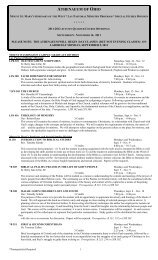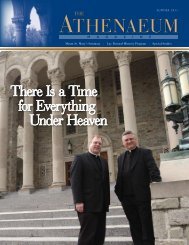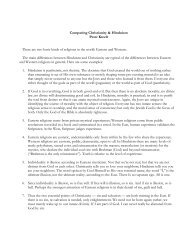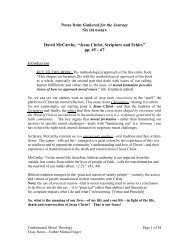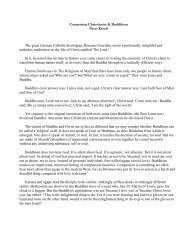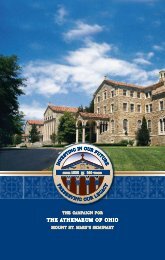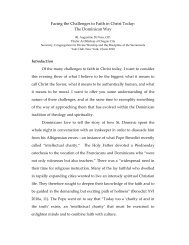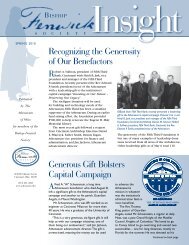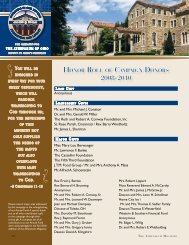2010 Catalog cover - The Athenaeum Of Ohio
2010 Catalog cover - The Athenaeum Of Ohio
2010 Catalog cover - The Athenaeum Of Ohio
- No tags were found...
You also want an ePaper? Increase the reach of your titles
YUMPU automatically turns print PDFs into web optimized ePapers that Google loves.
literary criticism, the Bible as literature, the<br />
transmission of the Bible, its various<br />
English translations and textual criticism.<br />
Papers will be required. (Schehr, 3<br />
Credits)<br />
B 231 Introduction to Old Testament<br />
<strong>The</strong>ology and <strong>The</strong>mes<br />
This course is designed to help the<br />
student: 1) understand the context of each<br />
book of the Old Testament, 2) appreciate<br />
the poetic and narrative skills witnessed in<br />
the Old Testament, 3) comprehend the<br />
themes and theologies developed in the<br />
Old Testament. (Schehr, 4 Credits)<br />
B 232 History of Israel in Biblical Times<br />
This course will study the history of Israel<br />
from its roots in an Ancient Near Eastern<br />
milieu, its election and call by God, its<br />
settlement in Canaan, and its development<br />
through the Intertestamental Period. (Lillie,<br />
3 Credits)<br />
B 233, Introduction to <strong>The</strong>ology and<br />
234 History of the New Testament<br />
An introduction to the world of the New<br />
Testament, to the various writings that<br />
comprise it (who wrote them, where, when<br />
and why), to the thought expressed by<br />
these writings and to the process by which<br />
they were gathered into the New<br />
Testament. (Callan, 6 Credits)<br />
B 253 Hermeneutics and Proclamation<br />
This course begins by exploring the 1993<br />
Pontifical Biblical Commission document<br />
<strong>The</strong> Interpretation of the Bible in the<br />
Church. It then concentrates on the<br />
proclamation of scriptural and liturgical<br />
texts that are used in public worship, and<br />
serves as preparation for vocal expression<br />
in homiletics courses. <strong>The</strong> study of<br />
communication theory is undertaken with a<br />
focus on interpreting texts as an essential<br />
step in making oral reading meaningful<br />
B 305<br />
B 306<br />
B 308<br />
and believable. Emphasis is given to style<br />
and quality of proclamation which bring<br />
written texts to power in the spoken word.<br />
Importance is placed on student presentations<br />
and proclamations throughout the<br />
course. (Shea, Morman 3 Credits)<br />
Biblical Psalms: Prayer in the Life of<br />
God’s People<br />
<strong>The</strong> structure and meaning of the Psalms<br />
will be studied as a means to understanding<br />
the content and meaning of the<br />
prayer of God's people from their<br />
Hebrew roots. <strong>The</strong> continuing use of the<br />
Psalms in Christian history will then be<br />
considered with the various emphases of<br />
Christian traditions. Application of the<br />
history and content will be explored as a<br />
means of deepening personal<br />
involvement in liturgy and in personal<br />
prayer. Prerequisites: B 231, B 232 or<br />
LPB 301. (Lillie, 3 Credits)<br />
<strong>The</strong> Integrative Quality of the Biblical<br />
Wisdom Literature<br />
This course presents the text and content<br />
of the Biblical Wisdom Tradition in relation<br />
to the thought of its own time and its<br />
significance for our time. Emphasis will be<br />
placed on its integrative quality for the<br />
orientation of the human person in the<br />
search for personal development and<br />
holiness. Prerequisites: B 231, B 232 or<br />
LPB 301. (Lillie, 3 Credits)<br />
Isaiah: God’s Children Lost and<br />
Found<br />
<strong>The</strong> purpose of this course is to provide<br />
the student with an opportunity to<br />
appreciate the artistry and theology of the<br />
Book of Isaiah. We will approach the<br />
book as a literary unity and engage in<br />
close reading of selected passages with<br />
an aim to: 1) gleaning what we can of the<br />
historical milieu; 2) dis<strong>cover</strong>ing what<br />
56



